Ila Gupta, the director, and producer of the annual festival dedicated to Indian arts is among the event’s most crucial pillars, describing how 25 years of her work with arts and artists became her life and passion.
Taking place across three cities, seventh India by the Nile festival (March 5-17) took Egypt by storm. Over seven years the annual event — launched in 2013 — has become known to a large segment of the Egyptian population. A one of a kind, multidisciplinary showcase for India’s classical and contemporary culture — dance, music, theatre, film, literary encounters, creative workshops, cuisine, yoga and wellbeing, crafts, merchandise, as well as discussions of its connections with Egypt — it has given the Egyptian audience the opportunity to come in contact with such Indian stars as Amitabh Bachchan, Javed Akhtar and Shabana Azmi as well as acclaimed artists like Grammy winner Vikku Vinayakram, renowned violinist L. Subramaniam, Indian Ocean, Dona Ganguly, Sonam Kalra, Shubha Mudgal, and many others.
India by the Nile is the result of hard work by many parties, from Teamwork Arts (a company that specializes in presenting Indian art through festivals all over the world) to the Indian Embassy in Cairo and many Egyptian partners.
For years I’ve written on this culturally fascinating event, full of color and value, speaking to many participating artists as well as the Teamwork Arts Director Sanjoy Roy. But among the sprawling creative medley, one woman stands out. She can be seen in the corridors of the theatres, to one side of the open-air performance spaces, and in meetings with Indian and Egyptian officials — organizing, supervising, or simply making conversation.
Ila Gupta, the director, and producer of this incredibly rich event is among the event’s most crucial pillars. Invisible though she tries to be, she manages to grab our attention — gently, subtly — with her professionalism, kindness, and boundless energy. Indeed, nothing would work if she didn’t visit regularly, let alone being present during the festival events themselves.
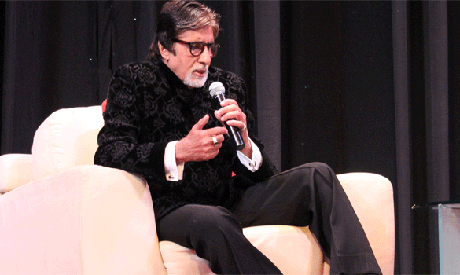
Amitabh Bachchan visits Cairo in March 2015 as part of India by the Nile Festival (Photo Ati Metwaly)
“I have always been interested in arts nevertheless. Twenty-five years ago, I got an opportunity to join the Teamwork Arts company. At that time, Sanjoy Roy focused on producing television shows, created films for UNICEF, WHO, and other big organizations. Around 2000, he got an opportunity to work with the Edinburgh fringe festival. I remember how wonderful the atmosphere was: during the festival the city turns into one big stage with performances on the streets, in theatres, in churches… We brought a few Indian performing arts productions to Edinburgh and they were very well received. It was all very encouraging. This was how we moved forward with live entertainment as we wanted to show to people around the world what India has in terms of classical and contemporary culture.”
Through public and private partnerships, they have thus been organizing Indian festivals in Singapore, Hong Kong, Indonesia, Australia, the USA, the UK, South Africa, and Zimbabwe, with Egypt becoming “one of our key festivals along the way. Most recently we launched a festival in Turkey as well and we are eyeing Kenya.” Gupta is not responsible for all the festivals since Teamwork Arts has broken up its geographical reach.
“My main focus is Egypt and Turkey now. Other responsibilities include the Jaipur Literature Festival which we launched in 2007. I also do curation work for many of our festivals, including those in Australia, Hong Kong, and Singapore.”
By the time I meet Gupta in mid-March, she has concluded her two-week stay here and is headed to Turkey to oversee the festival there, before returning home.
Over the years India by the Nile has evolved considerably. The first three editions of the festival included a large-scale stage production, a Bollywood show presenting an artistic extravaganza of dance, singing and a lot of fun, all of which attracted a large audience while demonstrating the Egyptian public’s unconditional interest in Bollywood.
Together with the show came the India-based French choreographer Gilles Chuyen, who gives a Bollywood dance workshop, one of the festival’s most popular elements which continues through the years.
“In the past 20 years, Bollywood has become a hugely popular attraction and we are very happy to have brought musical shows presenting this art. The musical is like a little showcase of all that India is: colors, vibrancy, costumes, the music, and the dance, the combination of classical and contemporary… It’s wonderful how people in Egypt respond to Bollywood. We realize that Bollywood has become a cultural symbol of India yet with the festival, we also wanted to expose our Egyptian friends to a lot of other aspects of our country’s cultural aura and artists representing other creative sectors which are not always given the place that they should be given.”
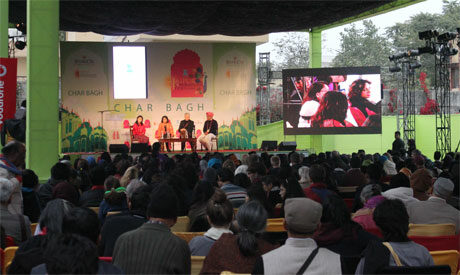
Jaipur Literature Festival, 2014 (Photo: Ati Metwaly)
Many Teamwork Arts festivals are motored in cooperation with Indian embassies in their respective countries.
“When we decided to launch the festival in Egypt, the then ambassador Navdeep Singh Suri felt — sharing Teamwork Arts belief — that one of the powerful ways to engage people with India is through our culture: our music, dance, theatre, films, food. On the other hand, at the time there was this global perception that Egypt may not be safe for people to visit. We felt a way to tell the world that Egypt is safe and alive is by bringing our artists, musicians, and dancers to Egypt. All those people, including the consecutive ambassadors, go back to India or move across other countries telling how beautiful Egypt is. We keep doing this through all the editions of the festival.”
With their uniqueness and iridescent beauty, India’s classical and contemporary dance and music forms are undeniably among India by the Nile’s highlights. “Music is the biggest communicator because it goes beyond language and geographies; it speaks to us beyond the lyrics.” Gupta’s eyes brighten as she talks about the living movement, colors, costumes, and many messages that touch the soul even if the audience does not decipher the classical vocabulary.
“India has such a rich tradition of arts, as does Egypt. We think that India and Egypt are really close, kind of similar in their cultural share. Maybe both countries differ in their artistic formats, yet at the end of the day, we all talk about the same thing: fun, joy, love, peace,” Gupta says giving an example of Tanoura dancers and the heart she takes from the whole atmosphere that comes with it.
While Gupta speaks about India by the Nile, the passion that emerges from her words catches my eyes and ears. Despite the many responsibilities and obvious pressures that the festival’s procedural aspects bring along, she finds happiness in the arts which she not only promotes as part of her job but also truly enjoys.
Teamwork Arts cooperates with many partners, the Indian Council for Cultural Relations (ICCR) being among the most important. Founded in 1950 by Maulana Abul Kalam Azad, ICCR is the Indian cultural body, operating under the Ministry of Culture with the aim of helping promote Indian arts outside the country and bringing foreign artists to local audiences. A lot of Indian artists enroll in ICCR becoming part of its big cultural network. ICCR supports the artists especially those representing classical art forms which do not attract as big an audience as other creative forms.
“For instance, when an ambassador of India to Egypt invites us to organize a festival, we ask ICCR to give us a hand. They help us through paying for the expenses of the artists who are associated with them. They cannot support the entire festival of course so we also have to rely on the embassy, many other bodies, and sponsors including TCI Sanmar, one of the major Indian investors in Egypt, which has been with us for seven years now. Otherwise, how could we get the money to bring many eminent Indian artists to Egypt?”
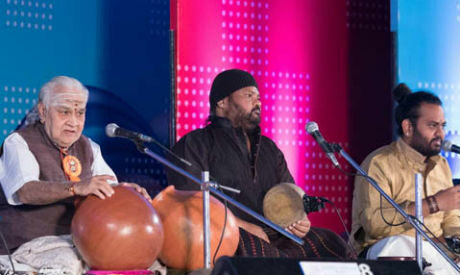
Vikku Vinayakram & V Selvaganesh- Indian Percussion Ensemble during India by the Nile Festival 2019 (Photo: courtesy of India by the Nile)
It is not easy to make Gupta talk about her life outside festivals, arts, and culture, operational and managerial aspects of her job. Totally submerged in her work — her life and passion — she reveals how she began working with the Teamwork Arts and how she was supported by many on her journey, including Sanjoy Roy whom she describes as a very open person and her family.
“I started working when my daughters were only three and seven years old. I have a very supportive husband and larger family. If you have all this backup, it is easier to work and enjoy the job. When my daughters were still in school, I would take smaller roles in the administrative and PR part of Teamwork Arts; I stayed in Delhi. Of course, my inability to be home 24/7 created a family dynamic different to the one experienced by children living with a stay-at-home mum. However, I feel that when children are brought up in a home where a mother works, they tend to be very independent. My children are proud of what I do while I fully enjoy it all.”
Gupta adds that today one of her daughters also works in Teamwork Arts, as a co-producer, specifically in the programming of literature festivals, with the Jaipur Literature Festival [JLF] being the biggest and the most prestigious in all Asia “and in the world actually,” a festival that brings over 300 renowned speakers from all around the world, including the Nobel laureates and other prominent award winners in literature. The company also holds numerous small JLFs, as Gupta refers to them, in the USA, UK, Australia, etc.
As the years passed, the company began growing as did Gupta’s children. With festivals kicking off in many countries, Gupta was ready to take on bigger responsibilities and travel as well.
“I can’t see myself doing anything other than what I do. Twenty-five years in this industry has really taught me so much; it has exposed me to all kinds of people, whether they are artists of India or those of different countries.”
Indeed, through her work, Gupta is able to have closer insights into each culture, she sees much more than any tourist can. Her job has also developed in her an ability to deal with different people, cultures and a variety of cultural institutions, bodies supporting the festivals in each country, people working within those bodies as well as the artists.
Gupta explains that in this amalgam of people, cultures, and tastes, one learns how to deal with everybody.
“I keep navigating between different personal values, prides, and egos,” she smiles underlining that the most important factor is to treat everybody with respect.
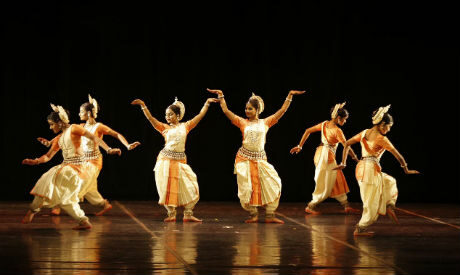
Odissi dancers with choreography by Ratikant Mohapatra, during India by the Nile 2019 (Photo: courtesy of India by the Nile)
Today, despite the many springs that passed since she began her journey with Teamwork Arts, Gupta is still filled with unparalleled energy. She continues to move across the world, traveling once every two months on average, either staying during one festival or visiting to make necessary arrangements for the next.
“I will continue working for as long as I can; it is all very satisfying.”
Time and again, she reiterates the importance of reaching out to everyone with arts.
“Music, dance, and many other creative forms have no boundaries. They carry a universal language regardless of the nationality, culture or religion of the performers or the audience. In India, traditionally many centuries ago, music and dance were offerings to the gods; take temple dances as an example. We also have a tradition of Qawwali [devotional music and songs] performed in the dargahs [India’s Muslim mausoleums or shrines].”
Gupta explains that since in today’s India arts are becoming a “public affair,” that is open to everyone.
“This development is very natural because music or any other art form opens up your heart and mind; it carries a freedom of expression using a language that is not limited by words. This freedom needs to exist everywhere and we feel that all expressive arts represent the best way to connect with people. We are passionate about sharing this language with the world, underlining the importance of connecting minds and souls. As they say, food fills your stomach but art fills your soul.”
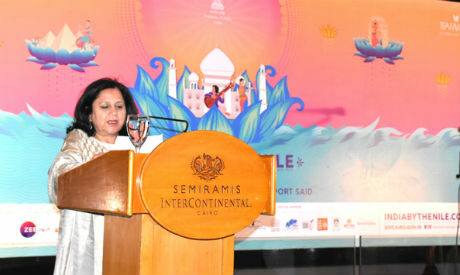
Ila Gupta during the press conference opening India by the Nile Festival 2019 (Photo: courtesy of India by the Nile)
When India by the Nile closed on March 17, Gupta had a packed schedule for the following weeks, so it was too early to find out what India by the Nile 2020 might bring to Egypt.
“All I can tell you is that we hope to expand even more, to reach more cities. This year we created a whole India day in Port Said. This was a very successful experience that we might repeat. We have a well-established base in Cairo and Alexandria; the Port Said experience was also lovely. We hope to receive support from other governorates to help us put the shows in different parts of the country.”
Concluding our meeting, Gupta echoed Sanjoy Roy, who always stresses the ability of art to bring about wealth.
“Not everyone understands that apart from the aesthetic and emotional values that it carries, art is important on a commercial level too. Artistic festivals further the economy of the city and country at large. Every hotel is booked; every shopping center is filled with visitors. A lot of economies have been boosted with such events and countries like ours should also look at art from a purely economic perspective.”
*A version of this article appears in print in the April 11, 2019 edition of Al-Ahram Weekly under the headline: Subcontinental passions
This article appeared in English Ahram on April 11, 2019, and has been reposted with permission.
This post was written by the author in their personal capacity.The opinions expressed in this article are the author’s own and do not reflect the view of The Theatre Times, their staff or collaborators.
This post was written by Ati Metwaly.
The views expressed here belong to the author and do not necessarily reflect our views and opinions.

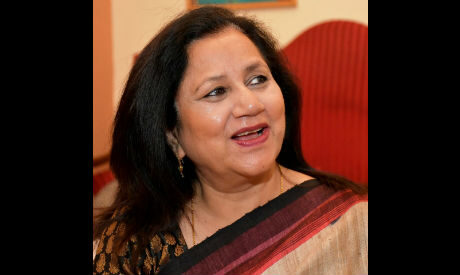
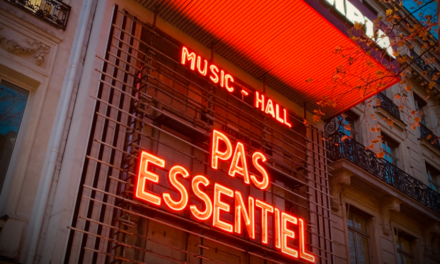
![Avignon 2019: Seeking Truth: On History, Memory and Fiction in Alexandra Badea’s Points de Non-Retour [Quais de Seine]](https://thetheatretimes.com/wp-content/uploads/2019/07/quais-440x264.jpg)














